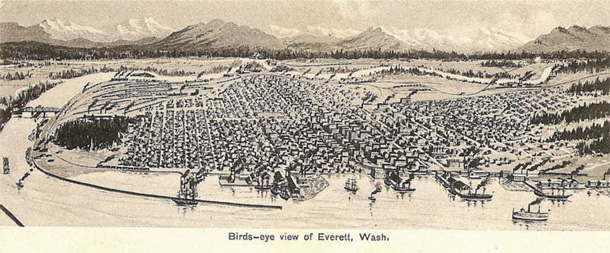Everett, Washington, an urban center of more than 100,000 residents in 2010, began in what is now the northern section of the city.
This section is bounded on the east and north by the Snohomish River and on the west by Port Gardner Bay, the arm of Puget Sound into which the river flows. From Everett’s beginnings in the early 1890s, this Port Gardner peninsula provided an ideal setting for the lumber, fishing and maritime industries. The natural harbor, vast nearby stands of virgin rainforests, abundance of Puget Sound fish and access to even richer Alaskan waters, and a railroad system that would connect Everett with the entire nation, all contributed to success in those industries. The traces the 1890 to 2010 history of the North Marina Redevelopment Area, referred to here as the North Waterfront, a 65-acre area where these industries started and thrived for decades, and where the Port of Everett began its stewardship of these waterfront areas.

This drawing of early Everett provides an artist's stylized perspective of the city and the waterfront.
First, a word about the scope of this study. The North Waterfront is defined as the area east of the Snohomish River channel, north of 17th Street, west of West Marine View Drive, and south of 10th Street. Our report focuses on the history of the North Waterfront lumber and shingle mills, commercial fishing, and boat building from 1890 to 2010, and the influence of these industries on the development of Everett. We also discuss a few special features, such as the Weyerhaeuser Building, and we take the liberty of including a couple of mills, Clough-Hartley on the south and C-B Lumber and Shingle on the north, whose properties extended slightly beyond the North Waterfront boundaries. In addition, we include a small section about Jetty Island and the former stairs from the Grand Avenue bluff to the bayfront because of their significance to the North Waterfront. Regarding time, we confine our study to the post-1890 era. We make no attempt to describe the rich history of the Native American population that had lived in and around the pre-Everett bayfront for thousands of years. Also, there is no description of the post-1890 natives’fishing and other activities which certainly occurred but were not based in the North Waterfront.
Finally, we endeavour to examine the lumber and shingle, fishing and boat building industries in the context of Everett’s broader history and other North Waterfront development of the 1890 to 2010 time period.
— Lawrence E. O’Donnell and Jack C. O’Donnell

The Evolution of a Vibrant Everett Waterfront
A book about sawdust, salmon
and speedboats
Book Purchase Available:
Books can be purchased for $30 plus tax at the Port's administration offices at 1205 Craftsman Way, Everett, WA 98201; checks are preferred.

About the Authors
Lawrence E. “Larry” (left) and Jack C. O’Donnell are brothers, friends and neighbors. Born and raised in Everett, they both took similar career paths as teachers. Larry was a teacher and administrator in Everett Public Schools for 30 years. Jack taught in schools in Snohomish County for 39 years, primarily history to children in grades 4 through 8. Both have a mutual interest in local history, and served on the Everett Historic Commission. Jack was the longest-serving member and Larry was its first president. Jack is also a founding board member of Historic Everett. Their research into the Everett’s North Waterfront was in many ways research of their own history, of their friends’ and classmates’, and of their hometown.